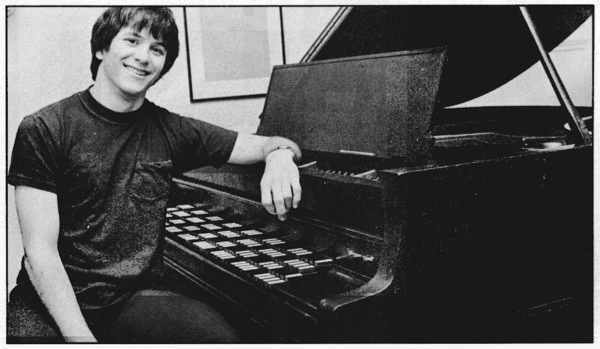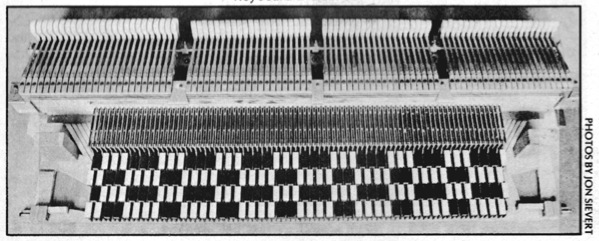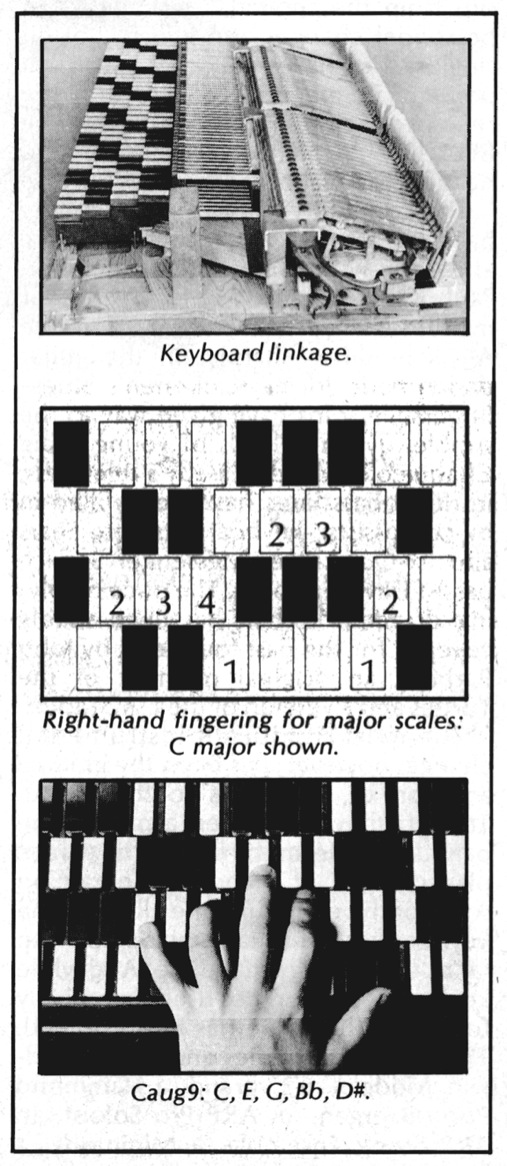Uniform
Keyboard
Musical
Instrument
Design
Check out:
Frequently Asked Questions

340 Western Road, Unit 14
Reno, NV 89506-7616
(775) 323-3400
 DASKIN Manufacturing
DASKIN Manufacturing

Born and raised in San Francisco, 21-year-old Paul Vandervoort is an accomplished musician and has been building experimental keyboards for several years. Accounts of his projects have appeared in the Musical Six-Six Newsletter [Box 207, Purdin, MO 64674]. am 8-page quarterly in English and Esperanto which is devoted to keyboard design reform.
There have been many attempts at such reform over the years, none of which has yet gained any widespread acceptance. Partially this is because keyboardists haven't wanted to go to the trouble of learning a new fingering system--a concern which is certainly understandable. But partially, too, it has been because of deficiencies in the designs that have been proposed in the past; and the editors of CK haven't found any major theoretical or practical flaws in the Vandervoort keyboard. It is a well thought-out combination of the best features of several earlier ideas by other inventors, and definitely deserves serious consideration. Whether it merits adoption is, of course, a question that only the keyboardists of the world can decide.
Vandervoort is currently developing a piggyback unit to be set on top of any existing keyboard, so that musicians can experiment with his system conveniently and inexpensively. Until this unit becomes available, however, or until a manufacturer can be induced to offer instruments with a Vandervoort keyboard option, the design described below will unfortunately be available only to the intrepid do-it-yourselfer.
--Ed.
One of the things that all readers of Keyboard Magazine have in common is their familiarity with the standard diatonic-chromatic keyboard. Like many another aspects of music, the standard keyboard evolved several hundred years ago, and was very well suited to the music of that time. But in spite of the large-scale changes that have taken place since then in the world of music as a whole, the standard keyboard has remained nearly un-changed. It makes sense to ask whether the keyboard we are now using is the best one for the kind of music we are now playing. I believe it is not.
A musical instrument should be designed in such a way that it offers the musician the maximum freedom to be creative without imposing any un-necessary technical impediments. But the standard keyboard suffers from a great drawback due to the necessity of learning a different set of chord shapes and fingerings for each key. The adoption of the equal-tempered scale in the early 1700s made the difference between key fingerings superfluous, but the cumbersome fingering system made necessary by the standard keyboard has of course been retained.
A further difficulty with the standard keyboard is the smallness of the margin for error in striking the keys. It doesn't really make sense for the keys to be as wide as possible and the cracks between them as narrow as possible. When each white key is about 7/8" wide and the cracks between them about 1/16" wide, as is the case on the standard keyboard, a finger striking the note D has about 1" of space between the right side of the C and left side of the E. But if all the keys were 3/4" wide, 1/8" narrower than before, with spaces between them 3/16" wide, the centers of the keys would be the same distance apart as before, but there would be 1/8" more leeway between the right side of the C and left side of the E.
Narrow cracks restrict a player's speed in that they make it difficult to orient the hands precisely. When one is playing on the white keys, it is possible to tell that the fingers are drifting only when one strikes the edges of adjacent keys. It thus requires extra effort to avoid accidentally striking two keys with one finger. When the cracks are wider, on the other hand, the fingers can feel the edge of one key without striking the next, and the drift is immediately halted. The designers of typewriters and pocket calculators are aware of this principle, and my experience has been that a keyboard with wider cracks (provided that the keys themselves are not made too narrow) can be played faster and with greater ease than a standard keyboard can.
The keyboard I have been building and playing for the past three years is shown in the accompanying illustrations. Because it is very simple in concept, and because it has fully lived up to my expectations, I am confident that it's essential design is ideal. It cannot be patented, because it resembles other, older designs, notably that devised by the Hungarian Paul von Janko in 1883. Anybody can build one for themselves, provided they have access to raw materials and tools, some woodworking expertise, Yankee ingenuity, and more free time than they think they'll need.

My keyboard consists of four rows of keys, each row sounding a whole-tone scale. The first (nearest the player) and third rows contain the notes C#, Eb, F, G, A, and B, while the second and fourth rows contain the notes C, D, E, F#, Ab, and Bb. Thus each key lever has two touch-plates connected to it: when one moves, the other moves as well. Four rows are provided so that the player's hands can always assume a comfortable position. There are several ways to structure any pattern of notes, and of these, the one that best fits the natural shape of the hand can be chosen.
Significant advantages are offered by this arrangement. Scales and chords can be triggered the same way in all keys, and transposition of a piece to at least six keys, those whose tonics make up a whole-tone scale, requires no change in fingering. Pieces which are fingered using only two or three of the rows of keys can be played exactly the same way in all twelve keys.
My keyboard is also shorter than a standard keyboard, octave for octave. The octave span of 5.04" is about the same as the stretch from C# up to Bb on a standard keyboard. The .84" distance between the centers of laterally adjoining keys remains constant from row to row, but the keys in the the first row, which are struck most often by the side of the thumb and the fifth finger, are slightly wider and the gaps between them narrower, while the keys in the top row, falling most often beneath the middle three fingers, are slightly narrower. The gap between keys averages about .25", which is narrow enough to allow one finger to strike two keys at once, if desired. Each row of keys is 1.35" deep, for a 5.4" overall depth.

Many keyboard players occasionally play grace notes by sliding a finger onto a white key from an adjacent black key. On my keyboard, this kind of slide can be played not merely from accidentals onto naturals, but from any note to those chromatically adjacent to it. By beginning on the top row, two or even three chromatic grace notes can be played with one finger, or entire chords can be slid up or down chromatically like barre chords on a guitar fretboard.
Anything which is playable on the standard keyboard can be played on mine, with the exception of the diatonic (white-key) and the pentatonic (black-key) glissandi. However, a a little experimentation with glissandi on the new keyboard will turn up dozens of novel ear-catching effects.
The new keyboard lends itself well to all styles of music. A classical player will be able to play many pieces which had previously been reserved for those gifted with larger hands, and passages which before had been awkward can be played with comfort and fluidity. A jazz player will find a multitude of new chord structures made possible by the closer spacing. Wider voicings may be used, giving a fuller sound.
The uniform, symmetrical note arrangement greatly facilitates both composing and playing. Basic chord changes very quickly become second nature, since they are the same in every key. The player may then direct more attention to the music, and less to how to play it. Also, since less time is required for mastering the basics, one can sooner progress to more difficult music. These are surely significant advantages.
The keys are colored either white or black according to the same system used on the standard keyboard: playing the white keys produces a C major scale. Thus the first and third rows of the keys have four white keys alternating with two black keys, while the other rows have three of each color alternately. In addition, it would be a good idea to add small buttons or ridges to the C's in the rear row, as some means must be provided with which blind musicians can orient themselves.
A keyboard of this type can be built for any existing instrument. To date, I have built two for acoustic and two for electronic instruments. The process involves removing the original keyboard and using it as a model for the dimensions of the new one. With an acoustic piano, the old key levers and the frame made to hold them are replaced. The rest of the action, including the hammers, remains. If desired, the old keyboard can later be reinstalled.
As this is a short keyboard which must connect to a normal-length action, the levers will radiate at an angle from the keys to the underside of their respective wippens (the part of the action which drives the hammer). The levers will then be most sharply angled at the bass and treble ends of the keyboard, and nearly straight through the midrange.
it is best not to design the keyboard with each note's two touch-plates attached to their lever. If they are attached, the upper touch-plate will be closer to the fulcrum, requiring therefore more finger force than the lower one for producing a note of the same loudness. The force can be equalized by securing the key, with both touch-plates attached, to a parallelogram linkage above the front end of the lever.
No new keyboard stands any real chance of being widely adopted unless it offers performers all the good characteristics of the standard keyboard, plus some other features valuable enough to make converting from the old system to the new a worthwhile undertaking. Since my keyboard makes it possible for everybody to play faster, transpose more easily, and reach larger chords without breaking them, I'm convinced that it satisfies these conditions. I hope that eventually it can be made commercially available, because I believe that if other keyboardists have the opportunity to try working with it, they will be as pleased with the results as I have been.